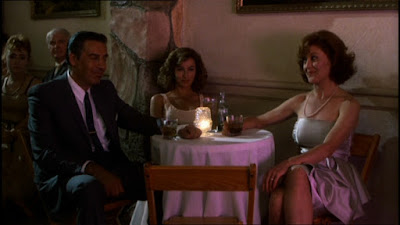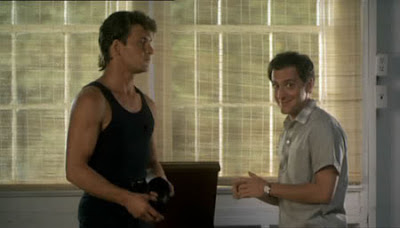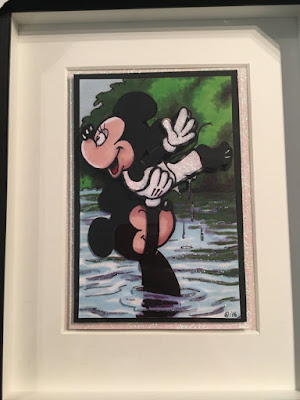A couple of the reviews indicate that Naish argues that the final dance scene was a fantasy.
Hayley C. RatherI have not read Naish's arguments for this idea, which is novel and thought-provoking. I grasp the idea's plausibility.
I found the author’s analysis of the end of Dirty Dancing utterly fascinating. I’ve watched the film numerous times and I’ve always thought that the ending was just super romantic and a perfect end to the film. Naish considers the idea that the whole ending was just a fantasy that Baby was having, it was what she imagined happened and that really the love story between her and Johnny was over when he left Kellermans earlier in the the film. I actually see that this is entirely plausible and it has made me really think about whether this is more likely than how I’ve always viewed it.
Hazel Smoczynska
The biggest revelation for me, however, was Naish’s suggestion that the final scene is interpreted as fantasy. It had never occurred to me how my own nostalgia for the film had blinkered my interpretation of it, which has always been as a straight narrative. Naish persuasively argues that Johnny driving away is the ‘real’ ending of the film, pointing out the signposts that indicate we are leaving reality and entering cinematic fantasy courtesy of Baby’s imagination.
In two previous articles of my blog here, I wrote about Dirty Dancing and the musical genre.
1) Is Dirty Dancing a Musical?
2) Recorded-Music Technology and the Musical Genre
In those articles, I discussed the concept of diegesis, which is used to analyze movies. The diegesis is the story that the characters are actually experiencing. The diegesis does not include background narration or music.
For example, in opening scene of Dirty Dancing, the Houseman family is riding in a car as on older Baby is narrating about the year 1963 and so forth. The family's presence and activity are diegetical. Baby's narration is non-diegetical.
As another example, the movie audience sometimes sees characters put a vinyl record onto a record player and then dance to the music. On these occasions, the music is diegetical. On the other hand, there probably are moments -- I would have to watch the movie again to find some -- when music plays subtly on the soundtrack to affect the audience subconsciously. Such soundtrack music would be non-diegetic.
Dirty Dancing includes one remarkable scene depicting Baby's imagination. She is learning from Johnny to dance to the song "Wipe Out". A record player is not visible but must be present. As the music continues, Baby continues to practice her dance alone, outside. A record player cannot be present, so Baby must be imagining the music.
The music that Baby imagines while outside can be analyzed to be in a fuzzy region between diegetic and non-diegetic. The music is diegetic because she actually is conscious of her memory of the song and is dancing to it. The music is non-diegetic because it plays aloud only for the movie audience's benefit, in order to portray her mental activity. The soundtrack music could be eliminated from this outside scene, and the movie audience still might understand that she is imagining the "Wipe Out" song.
The "Wipe Out" scene gives the movie audience an insight into Baby's imagination. Baby sometimes imagines music that is not really audible.
Sometimes the movie provides views and sounds that do not really exist in the diegesis. Rather, these views and sounds are provided for the audience's benefit, to portray Baby's mental activity and provide insight into her imagination.
============
With the "Wipe Out" scene still in mind, let's now think about the scene where Baby and her parents are sitting at a table and watching the talent show.
 |
| Baby and her parents watching the talent show in the movie "Dirty Dancing" |
Baby is wishing that her teenage-girl life would be better. She should be the center of attention. Her intelligent altruism should be recognized and appreciated. Everyone should see that she is pretty and charming enough to attract a handsome boyfriend. These are the thoughts that preoccupy Baby as she sits at the table.
Then the following amazing event happens. Watch it critically, looking for elements that are unrealistic and implausible.
Did it really happen? Or did Baby just imagine that it happened?
Until this amazing event, the entire movie was realistic and plausible.
Furthermore, the movie's life lesson was strict. Baby and Johnny were mismatched. Their relationship was doomed. He had departed, and no matter what had happened, he ultimately would have departed. Baby had reconciled herself intelligently to that life lesson. She would go to college and devote herself to the studies that would eventually enable her to help society. After college she would marry a suitable man who would be accepted wholeheartedly by her parents.
Then suddenly, however, this amazing event destroyed that life lesson. Baby and Johnny were reunited. Her parents loved Johnny. Her life now would now enter in a new, fantastic course, full of dance, with wonderful Johnny.
======
On May 16, 1986, while the Dirty Dancing script was being finalized, the CBS television channel broadcast a notorious episode of its popular television series Dallas. This was the ninth season's last episode, and each season ended with a cliff-hanger.
In the cliff-hanger ending on May 16, the show's star Pam Ewing wakes up one morning and hears someone taking a shower in her bathroom. She goes to the shower stall to investigate. She and the television audience are surprised to see that the person taking a shower is her husband Bobby Ewing. Everyone was surprised because Bobby had been killed a year ago -- in the eighth season's cliff-hanger ending.
Bobby had departed from Pam forever, but now he returned in an amazing event.
The mystery of Bobby's return was explained on September 26, 1986, in the first episode of the tenth season. This explanatory episode was broadcast during the middle of the filming of Dirty Dancing, which took place from September 5 through October 27, 1986.
The explanation for Bobby's return on Dallas was that Pam had dreamed the entire ninth season while sleeping that night. Pam had an extraordinarily vivid imagination.
Both Pam Ewing and Baby Houseman had vivid imaginations, and therefore they both experienced the amazing returns of their beloved men who had departed forever. Maybe the air was full of imagination in mid-1986.































